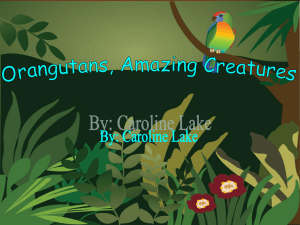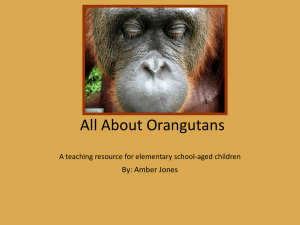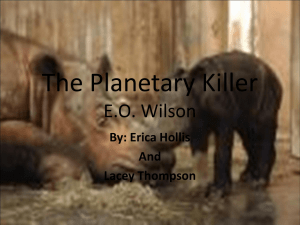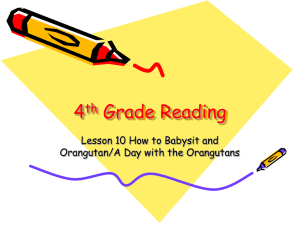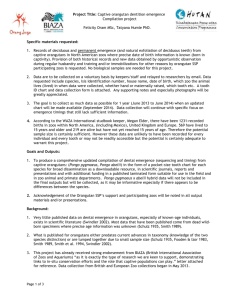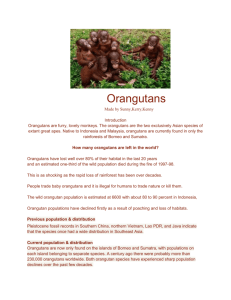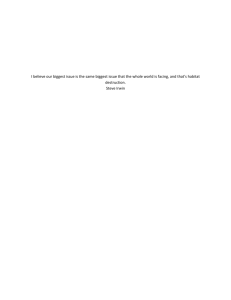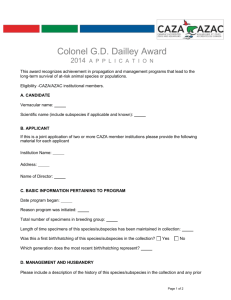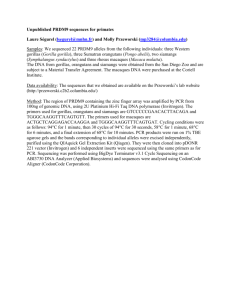HybridOrangutans_Subspecies
advertisement
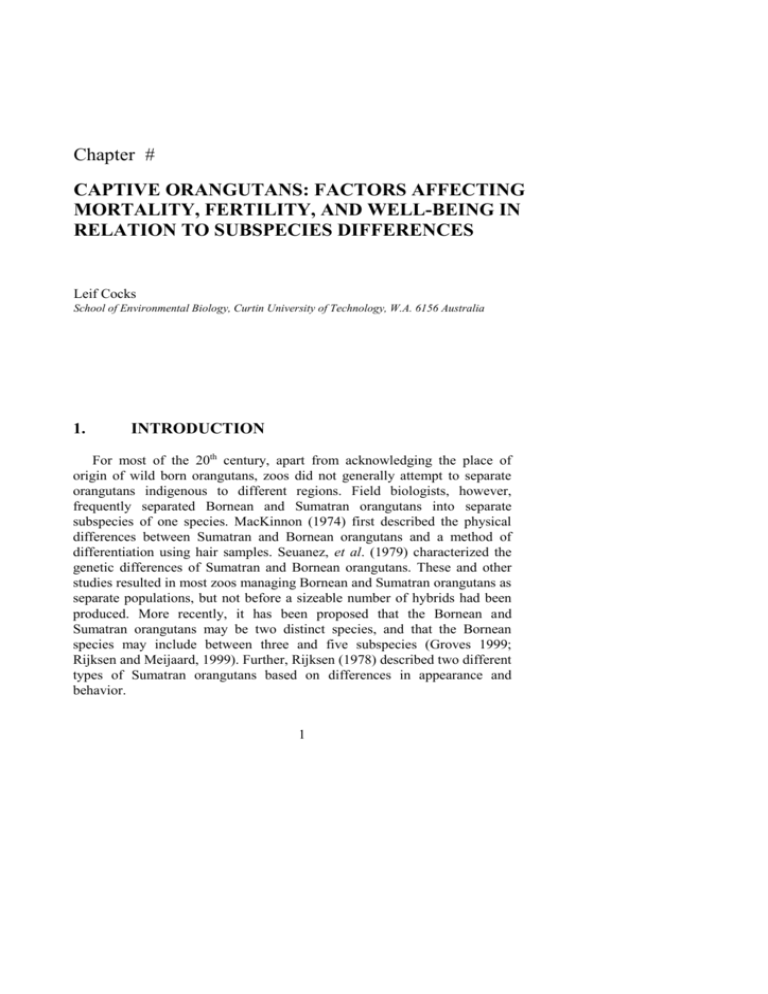
Chapter # CAPTIVE ORANGUTANS: FACTORS AFFECTING MORTALITY, FERTILITY, AND WELL-BEING IN RELATION TO SUBSPECIES DIFFERENCES Leif Cocks School of Environmental Biology, Curtin University of Technology, W.A. 6156 Australia 1. INTRODUCTION For most of the 20th century, apart from acknowledging the place of origin of wild born orangutans, zoos did not generally attempt to separate orangutans indigenous to different regions. Field biologists, however, frequently separated Bornean and Sumatran orangutans into separate subspecies of one species. MacKinnon (1974) first described the physical differences between Sumatran and Bornean orangutans and a method of differentiation using hair samples. Seuanez, et al. (1979) characterized the genetic differences of Sumatran and Bornean orangutans. These and other studies resulted in most zoos managing Bornean and Sumatran orangutans as separate populations, but not before a sizeable number of hybrids had been produced. More recently, it has been proposed that the Bornean and Sumatran orangutans may be two distinct species, and that the Bornean species may include between three and five subspecies (Groves 1999; Rijksen and Meijaard, 1999). Further, Rijksen (1978) described two different types of Sumatran orangutans based on differences in appearance and behavior. 1 2 Chapter # In my research on the factors affecting the well-being and survival of captive orangutans, I noticed some unexpected statistical results with respect to Bornean and Sumatran subspecies and subspecific hybrids. My results provide additional insight into the still-debated question of orangutan classification and resultant captive management strategies. 2. MATERIALS AND METHODS The data that I used for this analysis came from two sources: The International Orangutan Studbook (Perkins 1994; Table 1) and a survey I developed and sent to 214 institutions that now have, or once had, orangutans (see Cocks, this volume, chapter X for more detailed information). Table 1. Studbook and survey data used in this analysis Studbook Data International Studbook Number Facility Name Location Sire Dam Date of Birth Date of Death (if applicable) Sex Subspecies Wild or Captive Born Survey Data Adult Weight Diet Type Social Grouping Enclosure Type Occurrence of Infertility Dam’s Rearing Type (human or mother) Dam’s Maternal Experience Individual’s Rearing Type (human or mother) Individual’s Maternal Experience Occurrence of Infant Rejection Occurrence of Stereotypic Behavior Occurrence of Sterilization Subspecies From the data, I created a series of variables that I related to captive orangutan mortality, fertility, and well-being. Prognostic indicators have indicative power and included: overall survival, infant survival (0-5 years), infant rejection, stereotypic behavior, and maternal death and infertility. Captive husbandry variables have a predicted relationship to the prognostic indicator variables and included: sex, population, chronology, adult body weight, diet type, social environment, enclosure type, occurrence of sterilization, institution’s region, time from last sibling, dam’s rearing type, dam’s maternal experience, individual’s rearing type, age of dam at #. CAPTIVE ORANGUTANS: FACTORS AFFECTING MORTALITY, FERTILITY, AND WELL-BEING IN RELATION TO SUBSPECIES DIFFERENCES 3 individual’s birth, numbers of dam’s previous offspring, average interbirth interval, and individual’s age at birth of first offspring. I used SPSS (6.0) for Windows to analyze the studbook data. Since I had censored and uncensored data, I used “Life Tables” for the analysis platform. I used the Wilcoxon (Gehan) test statistic for survival variables. Categorical data (nominal or ordinal) were treated in two ways: prognostic variables that could not be ranked were tested for association using the Pearson Chi-Square and Likelihood Ratio Analysis (Freeman, 1987). Prognostic variables that could be ranked were tested for correlation using the Kendall and Spearman correlation coefficients (Freeman, 1987). I set the significance level at 0.05 for all tests. 3. RESULTS The population of wild Bornean orangutans is estimated to be three times larger than the Sumatran population (Wilkens, 1995). In captivity, the Sumatran population in the period 1943 to 1994 has been 88% the size of the Bornean population. In addition, a number of hybrid orangutans have been produced (Table 2). Table 2. Percentage distribution of populations Population Bornean Sumatran Hybrid Unknown * Number 736 652 290 297 Percentage 37.3 33.0 14.7 15.0 * These specimens often died before being identified and did not have offspring through which they could be identified before karyotyping was available. As the orangutans of unknown subspecies mostly died in infancy, very little data are available on these specimens, and so I omitted them from my analyses. I found a survival difference when comparing the three orangutan populations (p=0.0007, df=2; Figure 1). Statistically, there was no difference in the survival of the Bornean (n=729) and Sumatran (n=606) subspecies (p=0.7385, df=1), but hybrids (n=289) had a lower survival rate when compared to either Bornean (p=0.0002, df=1) or Sumatran orangutans (p=0.0017, df=1). 4 Chapter # Figure 1. The effect of population on survival I found similar results in my consideration of infant survival rates (Figure 2). There was a significant difference in overall infant survival for the three populations (p=0.0079, df=2). The survival of Bornean (n=196) and Sumatran (n=181) infant orangutans did not differ (p=0.3633, df=1), but infant survival in hybrids (n=108) was significantly lower when compared to Bornean (p=0.0024, df=1) and Sumatran (p=0.0199, df=1) subspecies. 1.2 1.0 .8 Cum Survival .6 .4 Subspecies Hybrid .2 Sumatran Bornean 0.0 -1 0 1 2 3 4 5 Years Alive Figure 2. Infant survival in three sample populations 6 #. CAPTIVE ORANGUTANS: FACTORS AFFECTING MORTALITY, FERTILITY, AND WELL-BEING IN RELATION TO SUBSPECIES DIFFERENCES 5 At 13%, the incidence of infertility was three times greater in the Bornean subspecies than in the Sumatran subspecies (4%; p=0.02209, df=1) or hybrid population (4%; p=0.02318, df=1; Figure 3). 140 120 100 108 100 80 60 54 Count 40 Infertility 20 0 no 15 Bornean yes Sumatran Hybrid Subspecies Figure 3. The effect of population on infertility In considering rates of maternal death, I found that the Bornean subspecies had an occurrence of 25% compared to 23% for Sumatran and 15% for hybrid populations (Figure 4). Hybrids appear to have a lower rate of maternal death, but the differences between hybrid and Bornean and hybrid and Sumatran populations are not statistically significant (Pearson Chi Square p=0.32239, df=2; Likelihood Ratio Analysis p=0.30069, df=1). 6 Chapter # 100 69 80 64 60 40 29 Count 26 20 19 Survived > 30 days 0 Bornean Female Survival 5 Hybrid Sumatran Survived 30 days Subspecies Figure 4. The effect of population on maternal death At 80%, hybrid female orangutans have a higher percentage of infant rejection than do either Bornean (29%; p=0.01018, df=1) or Sumatran (36%; p=0.01077, df=1) female orangutans (Figure 5). Bornean and Sumatran female orangutans did not differ in their infant rejection rates (p=0.4620, df=1). 60 50 14 16 40 30 34 28 20 Infant Rejection 10 8 0 Infant Rejection No Rejection Bornean Sumatran Hybrid Subspecies Figure 5. The effect of population on infant rejection The occurrence of stereotyped behaviors was nearly evenly distributed across the three orangutan populations (13.9% in Bornean, 8.6% in #. CAPTIVE ORANGUTANS: FACTORS AFFECTING MORTALITY, FERTILITY, AND WELL-BEING IN RELATION TO SUBSPECIES DIFFERENCES 7 Sumatran, and 10.7% in hybrids; Figure 6). My pairwise comparisons of each population are not statistically significant (Pearson Chi Ssquare p=0.58762, df=3; Likelihood Ratio Analysis p=0.35126, df=3). 200 138 123 100 50 Stereotypic Behavior Absent Count 20 0 Bornean 13 Sumatran Present Hybrid Subspecies Figure 6. The effect of population on stereotypic behavior 4. DISCUSSION There are at least two recognized orangutan subspecies: Bornean and Sumatran. In the wild, these two subspecies appear to have different behaviors. For example, Rijksen (1978) attributes the Sumatran orangutan’s heightened sociability to the more clumped distribution of its food resources in the Sumatran rainforest. I hypothesized that behavioral, genetic, and other differences of the two subspecies might influence the health and longevity of captive individuals. Further, subspecific hybrids were frequently produced in captivity, and I posited that this hybridization might have an effect on the longevity and health of hybrids. Between 1946 and 1994, 32% of captive orangutans were Bornean and 33% were Sumatran. In the wild, the numbers of Bornean orangutans are estimated to be approximately three times greater than that of Sumatran orangutans (Wilkens, 1995). It appears from the captive numbers that zoo personnel prefer to keep the more endangered subspecies or that more specimens have been imported from Sumatra. 8 Chapter # Hybrid orangutans, all of which are captive bred, represent 15% of the captive population. Most zoo staff now prevent these animals from reproducing, so they have no direct role in the species’ conservation. From this perspective, they occupy captive positions that could arguably be better filled by animals of the “pure” subspecies. I found little difference in survival between the two subspecies, but hybrids had a significantly lower survival rate than either subspecies. I found no evidence of a difference in infant mortality between the two subspecies. However, hybrid infants have a significantly higher infant mortality than either of the two subspecies. My results could occur either because zoo personnel selectively neglect hybrid animals or because hybrids are inherently weaker than are the two subspecies. As early as 1982, de Boer and Seuanez warned of the possible negative consequences of orangutan hybridization. To determine which argument better explains my results, I repeated analyses for species survival using orangutan data only from the North American region, where zoos operate under the authority of the Orangutan Species Survival Plan (SSP). By SSP mandate, hybrid orangutans have never been kept off-exhibit or, with the exception of prohibitions on breeding, otherwise managed differently compared to Bornean or Sumatran orangutans (Perkins, 1995). Most likely due to pressure from animal rights groups, North American zoo personnel have paid special attention to providing equal treatment of hybrid and “pure” orangutans. I found no difference in the survival of Bornean or Sumatran orangutans in North America, but again the survival of hybrid orangutans was significantly below that of the two subspecies (Cocks, 1999). I suspected that there might be a relationship between the reduced survival of hybrids and the geographic location of the zoo, as zoos in developing regions have been less strict about preventing of hybridization of Bornean and Sumatran orangutans. Zoos in developed regions have also sometimes sent unwanted hybrids to zoos in developing regions. My investigation shows that only 34% of hybrid orangutans are located in zoos developing countries (Table 3). Hybrids in both developed and developing regions show reduced survival, so there is scant indication of a link between the zoo’s geographic location and hybrid survival rates (Cocks, 1999). Thus, my data suggest that the lower survival rate of hybrid orangutans is due to reduced fitness associated with hybridization. Table 3. Distribution of orangutans in zoos in developed and developing regions of the world Bornean Sumatran Hybrid Developed Region 59% (n=434) 76% (n=480) 66% (n=191) Developing Region 41% (n=302) 24% (n=152) 34% (n=99) #. CAPTIVE ORANGUTANS: FACTORS AFFECTING MORTALITY, FERTILITY, AND WELL-BEING IN RELATION TO SUBSPECIES DIFFERENCES 9 The taxonomy of orangutans remains unresolved, yet how the various populations are classified has profound implications for conservation plans and for captive management. Genetic (Chemnick and Ryder, 1994), dermatoglyphic (Boedtani and Smits, 1994), and other (Groves, 1999) evidence support recognition of two distinct species (Bornean and Sumatran), but other taxonomic viewpoints exist. Andrew (1999), for example, advocates a monotypic orangutan species. Muir’s (1998 and this volume) DNA analyses reveal as much difference between the various Bornean populations as exists between Bornean and Sumatran orangutans. He maintains that there were ten occasions over the past million years or so when land bridges connected Sumatra and Borneo, therefore allowing the transfer of genetic material between some populations and preventing the simple division of orangutans into two species based on island of origin. If Muir’s view is correct, then at least some of the Bornean orangutans should be managed as genetically separate populations to avoid the negative effects of hybridization. It is interesting to note that the only significant difference that I observed in this study is the higher infertility of Bornean orangutans when compared to both Sumatran and hybrid individuals. Infertile offspring is one common result of crossbreeding incompatible populations. Infertile Bornean orangutans could also possibly result from the captive breeding of distinct populations of Bornean orangutans. This would support Groves’ (1999) recommendation that the Sumatran and Bornean orangutans should be separate species, with the Bornean species containing three subspecies. In addition to having reduced survival rates, I found that hybrids have a significantly higher frequency of infant rejection (80%) than do Bornean (29%) and Sumatran (36%) orangutans. As suggested by their shorter life spans, hybrids may have a host of mental and physical ailments that negatively impact on females’ abilities to raise their infants. This high occurrence of maternal rejection could also be due to less attention by caretakers placed on ensuring hybrid reproductive success. Many “pure” orangutans were wild-born (32%), but all hybrid orangutans are captive-born. Arguably, because hybrid animals are the product of the captive environment, they might, as a group, display more of the problems caused by captivity, including an inability to raise infants. I found, however, no significant change in infant rejection over time, and most wild-born animals enter captivity as partially hand-reared infants1. These facts appear to point to higher infant rejection as a result of hybridization. I found no 1As adults, hand-reared animals are more likely to reject their offspring than are motherreared animals. 10 Chapter # significant difference in the occurrence of stereotypic behavior for the three populations used in my analysis. This suggests that higher hybrid infant rejection was more closely associated with physical rather than mental weakness, although reduced viability apparently does not increase the occurrence of maternal death in hybrids. Bornean orangutans have a more solitary nature than do Sumatran orangutans (MacKinnon, 1974). In captivity, this may mean that Bornean orangutans suffer from higher levels of social stress more easily than their Sumatran and hybrid counterparts. Severe social stress has been shown to produce infertility in primates (Wildt, 1996). While I did find a higher occurrence of infertility in Bornean orangutans, I found no difference in the incidence of stereotyped behaviors for the three populations. This supports my argument that higher infertility is Bornean orangutans is a consequence of captive breeding between distinct populations. 5. CONCLUSION My data indicate that hybrid orangutans are genetically weaker and have much lower survival rates than do “pure” animals. This weakness may also contribute to higher rates of infant rejection among hybrids. Bornean orangutans have more than three times the occurrence of infertility than either Sumatran or hybrid orangutans. My results suggest this is due to hybrid infertility between genetically distinct Bornean populations. The data from my investigation support the position that Bornean and Sumatran orangutans are separate species and that there are likely to be further subspecies within the Bornean population. REFERENCES Andrew, P. (1999). Captive goals and taxon characteristics. Paper presented at XXIII Australasian Primate Conference, Taronga Zoo. Boedtani, A. N. and Smits, W. (1994). Dermatoglyphics of the Bornean and Sumatran orangutan. Paper presented at IPS Congress at IPS Congress 15, Kuta, Bali, Indonesia. Chemnick, L. and Ryder, O. (1994). Cytological and molecular divergence of orangutan subspecies. In: Proceedings of the International Conference on Orangutans: The neglected ape. (Eds.) Ogden, J.J., Perkins, L.A. Sheeran, L. Zoological Society of San Diego,San Diego. Pp. 74-78. Cocks, L., this volume. Cocks, L. R. (1999). Investigation of the factors affecting the well-being and survival of orangutans (Pongo pygmaeus) in captivity. Unpublished Masters thesis, Curtin University, Western Australia. #. CAPTIVE ORANGUTANS: FACTORS AFFECTING MORTALITY, FERTILITY, AND WELL-BEING IN RELATION TO SUBSPECIES DIFFERENCES 11 de Boer, L.E.M. and Seuanez, H. N. (1982). The chromosomes of the orangutan and their relevance to the conservation of the species. In: The orangutan: Its biology and conservation, (Ed.) de Boer, L.E.M., Dr. Junk Publishers, London. Pp. 135-170. Freeman, D. H. (1987). Applied categorical data analysis. Marcel Dekker, New York. Groves, C. P. (1999). The question of species and subspecies in orangutans. Paper presented at XXIII Australasian Primate Conference, Taronga Zoo. MacKinnon, J .R. (1974). The behaviour and ecology of wild orangutans. Animal Behaviour, 22: 3-74. Muir, C. C. (1998). The descendants of our ancestors: Investigating the population structure of the orangutan (Pongo pygmaeus) using DNA sequence and paleomigration modeling. Unpublished PhD. Thesis, Simon Fraser University, Vancouver. Muir, C.C., Galdikas, B.M.F., and Beckenback, B.T., this volume. Perkins, L.A. (1994). International studbook for the orangutan. Atlanta/Fulton County Zoo, Inc. Perkins, L.A. (1995). Zoo news on captive orangutan management. Pongo Quest, 7(1): 14-16. Rijksen, H. D. (1978). A field study of Sumatran orangutans (Pongo pygmaeus abelii). In: Ecology, behaviour and conservation. (Eds.) Veenman, H., and Zoren, U., Wageningen. Pp. Rijksen, H. D. and Meijaard, E. (1999). Our vanishing relative: The status of wild orang-utans at the close of the twentieth century. Kluwer Academic Publishers, London. Pp. 32 -49. Seuanez, H., Evans, H.J., Martin, D. E., (1979). An inversion in chromosome two that distinguishes between Bornean and Sumatran orangutans. Cynogenetics and Cell Genetics 23: 137-140. Wildt, D. E. (1996). Male reproduction: Assessment, management and control of fertility. In: Wild mammals in captivity. (Eds.) Harris, H., Kleiman, D.G., Allen, M.E., Thompson, K.V., Lumpkin, S., The University of Chicago Press, Chicago. Pp. 429-450. Wilkens, J. (1995). Captive species management plan for orangutan Pongo pygmaeus. Australian Species Management Program, ARAZPA, Sydney.
